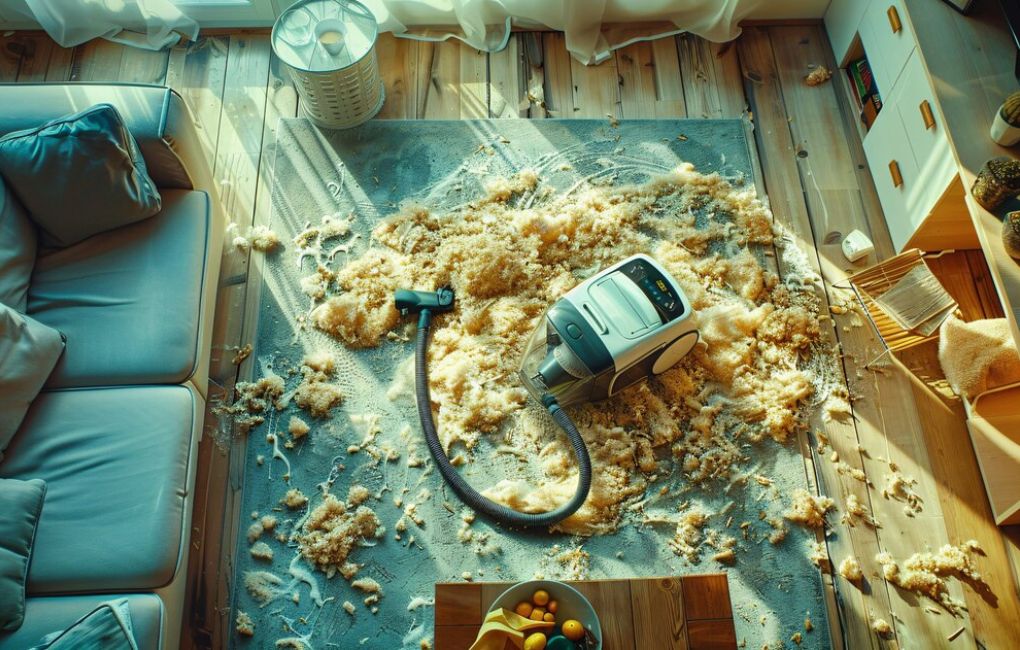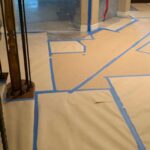Water damaged furniture, whether wood or upholstered, can indeed be salvaged with proper attention and techniques. When wood furniture is exposed to water, especially in areas prone to moisture buildup like bathrooms and kitchens, it can swell and become damaged. However, with timely intervention, many pieces can be restored. For instance, in the case of a water-damaged oak dining table from a burst pipe, swift action and careful restoration methods can often rescue the piece.
By following a comprehensive guide for repairing water-damaged wood furniture, such as drying the wood thoroughly, sanding down any swollen areas, and applying appropriate sealants or finishes, it’s possible to mitigate the damage and restore the furniture to a usable condition. While the furniture may not return to its original state, diligent repair efforts can significantly prolong its lifespan and aesthetic appeal, saving homeowners from the need to replace costly items.
Signs of Water Damage on Wood?
Discoloration
Inspecting for changes in the wood’s natural color is crucial when assessing water damage. Dark or discolored spots may indicate areas where moisture has penetrated the wood, leading to potential rot or mold growth. Black staining or splotches are often signs of mold infestation, which can compromise the structural integrity of the furniture.
Additionally, faded coloring on or between planks suggests prolonged exposure to water, which may weaken the wood fibers and contribute to warping or cracking over time. Identifying these color changes early allows for targeted treatment and restoration efforts to prevent further damage and preserve the integrity of the furniture.
Warping or Buckling
When wood absorbs water, it often swells, leading to noticeable changes in the surface texture. Raised or warped floorboards are common indicators of water damage, resulting in an uneven surface. Additionally, individual planks may exhibit cupping, where the edges curl upwards due to moisture absorption. Lifted nails or floorboards are further evidence of the swelling and expansion caused by water infiltration. Addressing these issues promptly is essential to prevent further structural damage and restore the integrity of the wood flooring or furniture.
Swelling
When wood absorbs moisture, it expands, leading to several common issues. Furniture, cabinets, or flooring may swell, resulting in noticeable changes in their dimensions. Tight-fitting doors or drawers can become difficult to open or close smoothly due to the increased size of the wood. This expansion can also cause stress on hinges and hardware, potentially leading to further damage if not addressed promptly. Managing humidity levels and implementing proper ventilation can help mitigate these issues and preserve the longevity of wooden surfaces.
Musty Odors
A damp smell often indicates the presence of mold growth, particularly in environments with high moisture levels. Mold thrives in damp conditions and can quickly proliferate, especially in hidden or poorly ventilated areas. Identifying and addressing the source of moisture is crucial to prevent further mold growth and maintain indoor air quality. Moreover, prompt remediation is essential to mitigate potential health risks associated with exposure to mold spores.
Soft Spots
Water-damaged wood tends to feel softer than usual when pressed due to its compromised structural integrity. The moisture absorbed by the wood weakens its fibers, causing them to lose their rigidity. This softness is often noticeable to the touch and can indicate significant damage, requiring timely drying and restoration efforts to prevent further deterioration.
Visible Mold or Mildew Growth
Excess moisture can lead to various problems, including mold growth, wood swelling, and structural damage. Identifying and addressing the source of moisture promptly is crucial to prevent further deterioration and maintain a healthy indoor environment. Monitoring humidity levels and implementing proper ventilation can help mitigate the risk of water damage in homes and buildings.
Why It is Important to Restore Furniture Damaged by Water?
Restoring water-damaged furniture is crucial for preserving cherished pieces and preventing escalating issues. If left untreated, water can cause wood to warp, joints to weaken, and mold to proliferate, posing health risks and compromising the structural integrity of the furniture.
By engaging in restoration efforts promptly, such as drying the wood, repairing any damage, and applying protective coatings, it’s possible to salvage the piece and return it to its former condition.
Neglecting the damage can result in permanent structural problems, potentially rendering the furniture unusable and requiring costly replacements. Ultimately, investing in restoration can be more cost-effective than replacing the entire piece, while also maintaining its sentimental and aesthetic value.
How to Fix Water Damaged Wood Furniture?
Repairing water-damaged wood furniture depends on the severity of the damage. Here’s a general guide to help you fix water-damaged wood furniture:
Assess the Damage
Assessing the extent of the damage is essential before attempting restoration. If the wood is severely warped, cracked, or extensively discolored, it may pose challenges for restoration efforts. These significant issues can indicate structural damage that may be difficult or impossible to repair fully, necessitating careful consideration of whether restoration is feasible or if replacement is a more practical solution. Evaluating the extent of the damage helps in making informed decisions about the best course of action for preserving or replacing the furniture.
Remove Excess Moisture
When dealing with wet wood, it’s crucial to remove excess moisture promptly to prevent further damage. Using a clean, dry cloth to wipe off the surface can help absorb excess water. Additionally, employing a hairdryer on a low heat setting can aid in gently drying the wood, facilitating the evaporation of moisture without causing excessive heat damage. These initial steps are essential for preparing the wood for further restoration efforts and mitigating the risk of mold growth or warping.
Sand the Surface
After the wood has dried completely, fine-grit sandpaper can be used to smooth out any rough or raised areas resulting from water damage. Sanding in the direction of the wood grain helps to maintain the integrity of the surface and avoid exacerbating the damage. This step prepares the wood for subsequent treatments or repairs, ensuring a smoother finish and enhancing the overall appearance of the restored furniture.
Apply Wood Conditioner
After sanding, if the wood appears dry and lacks luster, applying a wood conditioner can help restore moisture and enhance its natural color. Wood conditioners penetrate the surface, revitalizing the wood and bringing out its inherent beauty. It’s essential to follow the manufacturer’s instructions for proper application to ensure effective results and to avoid over-saturation, which could lead to uneven absorption or damage to the wood. This step rejuvenates the appearance of the wood, contributing to the overall restoration of the furniture piece.
Stain or Paint
In cases where water damage has altered the wood’s color significantly, restaining or repainting the furniture may be necessary to restore its original appearance. It’s crucial to select a stain or paint that closely matches the existing finish to achieve a seamless result. Prior to application, ensure the surface is clean and properly prepared to facilitate optimal adhesion and a uniform finish.
Seal the Surface
After allowing the stain or paint to dry completely, sealing the surface with a clear wood sealer or varnish is essential to protect it from future water damage and to enhance its appearance. The sealer creates a protective barrier that prevents moisture infiltration while also providing a glossy or matte finish, depending on personal preference. Proper sealing ensures the longevity of the restoration work and maintains the beauty of the furniture for years to come.
Repair Structural Damage (if applicable)
If the water damage has caused structural issues such as loose joints or cracked wood, you may need to repair these before refinishing the surface. Use wood glue to reattach loose joints and clamps to hold them in place while the glue dries. For cracked wood, you can fill the cracks with wood filler and sand them smooth before refinishing.
How to Prevent Wood Furniture from Water Damage?
To prevent wood furniture from water damage, you can take several precautions and proactive measures:
Apply a Protective Finish
Applying a waterproof sealant, varnish, or wood preservative to the surface of wooden furniture forms a protective barrier that effectively repels moisture and prevents water from penetrating the wood fibers. This barrier not only safeguards the wood against water damage but also helps to maintain its structural integrity over time. By creating a barrier against moisture intrusion, the sealant or varnish extends the lifespan of the furniture and minimizes the need for frequent maintenance or repairs.
Regular Maintenance
Regular inspection of wood furniture is essential to identify signs of wear, damage, or deterioration early on. Promptly addressing any issues such as cracks, warping, or discoloration helps prevent them from worsening over time and potentially causing irreparable damage. Taking proactive measures, such as repairing minor damages or adjusting environmental conditions, can prolong the lifespan of the furniture and maintain its appearance and functionality for years to come.
Use Coasters and Mats
Utilizing coasters, placemats, or trivets under glasses, cups, and hot dishes is essential for safeguarding the wood surface from water rings and heat damage, preserving its integrity and appearance. These protective measures also help prevent spills from seeping into the wood, minimizing the risk of water damage. Additionally, using mats or rugs in high-traffic areas serves to mitigate the transfer of water and dirt onto the furniture, reducing the need for frequent cleaning and prolonging its lifespan. By implementing these simple precautions, you can maintain the beauty and functionality of your wood furniture for years to come.
Control Indoor Humidity
Maintaining indoor humidity levels within the range of 40-60% is crucial for preventing wood furniture from swelling, warping, or cracking due to excessive moisture absorption. Utilizing a humidifier or dehumidifier as needed helps regulate humidity levels, particularly in areas prone to fluctuations such as basements or bathrooms. Consistent humidity control not only preserves the structural integrity of the wood but also minimizes the risk of mold growth and other moisture-related issues. By proactively managing indoor humidity, you can protect your wood furniture investment and ensure its longevity and aesthetic appeal.
Keep Furniture Dry
Promptly wiping up spills with a clean, dry cloth is essential to prevent water from seeping into the wood and causing damage. Leaving wet or damp items on wooden surfaces for extended periods increases the risk of water penetration, leading to swelling, warping, and potential mold growth. By promptly addressing spills and avoiding prolonged exposure to moisture, you can preserve the integrity of the wood and maintain the beauty of your furniture. Additionally, using coasters or mats under items can provide an extra layer of protection against water damage.
Use Furniture Wax or Polish
Regularly applying furniture wax or polish to wooden surfaces helps maintain their luster and beauty while providing an additional layer of protection against moisture and environmental factors. These products help nourish the wood, preventing it from drying out and becoming susceptible to damage. Furthermore, the protective barrier they create shields the wood from moisture penetration, reducing the risk of warping, cracking, and other forms of deterioration. By incorporating this simple maintenance routine, you can extend the lifespan of your wooden furniture and keep it looking its best for years to come.
Protect Outdoor Furniture
For wooden outdoor furniture, applying a weatherproof sealant or paint designed for outdoor use is essential to protect it from the elements. These specialized coatings create a barrier against rain, sun, and humidity, preventing damage such as warping, rotting, and fading. Additionally, storing outdoor furniture indoors during inclement weather or covering it with waterproof tarps when not in use can further prolong its lifespan by shielding it from excessive moisture and UV exposure. By implementing these protective measures, you can ensure that your outdoor wooden furniture remains in good condition and retains its beauty for years to come.
Inspect and Repair
Regularly inspecting wood furniture for signs of damage such as cracks, loose joints, or peeling finish is essential to catch issues early on. Prompt repair of these issues is crucial to prevent further deterioration and water infiltration, which can lead to more extensive damage over time. By addressing problems promptly, you can maintain the structural integrity and appearance of your wood furniture, prolonging its lifespan and usability.
FAQs
What happens to wood when it gets wet?
When wood gets wet, it absorbs moisture, causing it to swell. This swelling can lead to warping, cracking, and eventual decay if not properly dried. Additionally, wet wood is more susceptible to mold and fungal growth.
Can water damaged furniture be repaired?
Water-damaged furniture can often be repaired depending on the extent of the damage. Repair methods may include drying the wood thoroughly, sanding and refinishing the surface, or replacing severely damaged parts. Professional restoration services may be required for extensive damage.
How do you fix water damaged swollen furniture?
To fix water-damaged swollen furniture, start by drying the affected areas thoroughly. Then, gently sand down the swollen parts to restore their original shape. Finally, refinish the surface to match the rest of the furniture.
Conclusion
To restore water-damaged furniture, begin by assessing the extent of the damage. If the damage is minimal, such as surface stains or slight swelling, you can often address it with simple DIY methods like gently wiping with a dry cloth or using wood cleaners. For more severe damage like warping or deep stains, professional restoration in Celina may be necessary. This can involve techniques such as drying the furniture thoroughly, sanding down swollen areas, and refinishing the surface to restore its original appearance.
Moreover, addressing the root cause of the water damage, such as fixing leaks or controlling humidity levels, is crucial to prevent future damage. Remember, patience and careful attention to detail are key in successfully restoring water-damaged furniture to its former glory.






